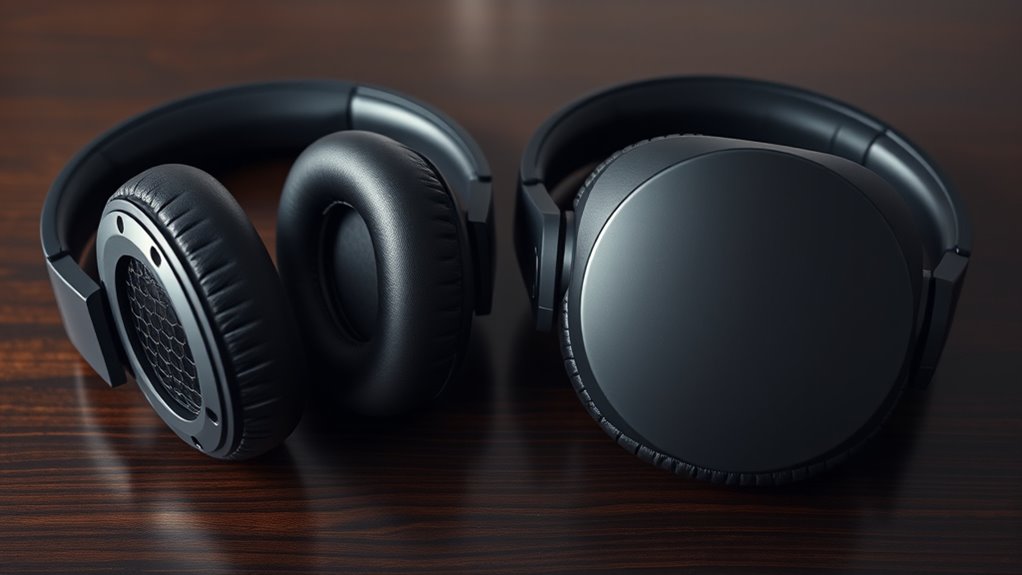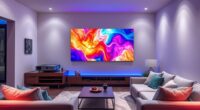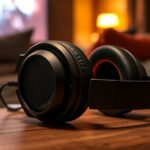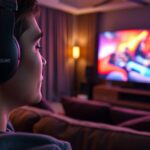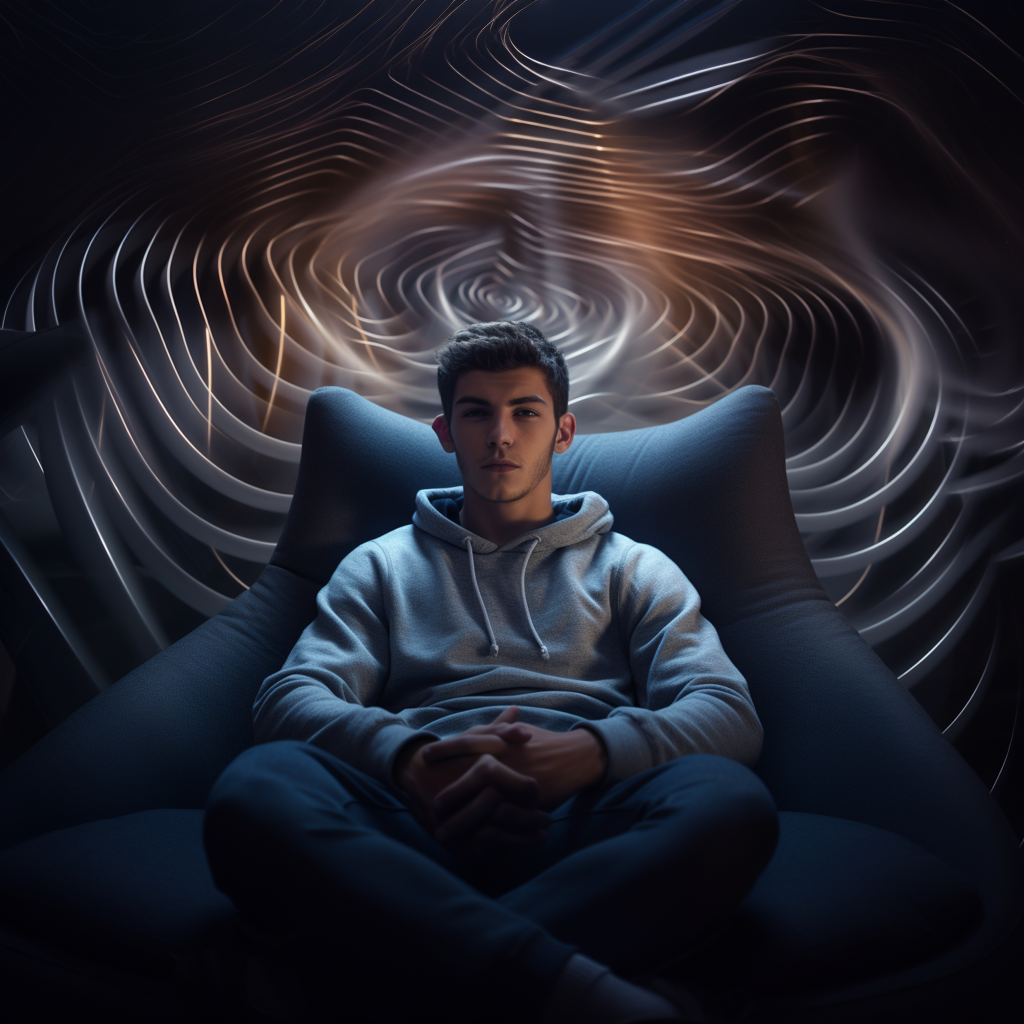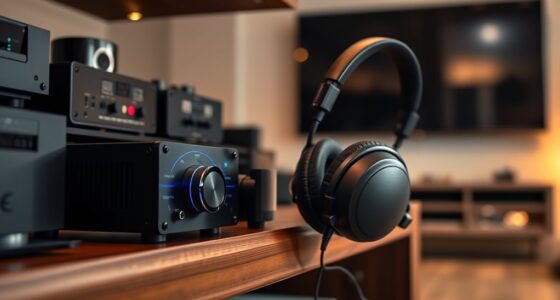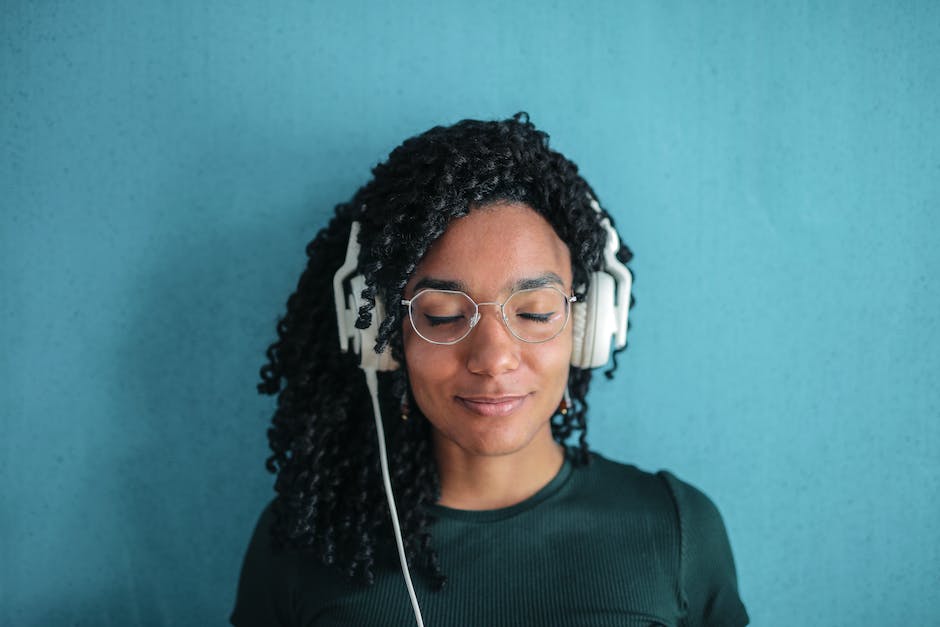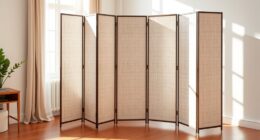If you’re watching movies at home, open-back headphones can offer a more natural, immersive sound with a spacious feel that mimics a speaker setup. They improve clarity and airflow but let in external noise and leak sound, so they’re less ideal for noisy or shared spaces. Closed-back headphones provide better noise isolation and focus, making them great for privacy and quiet environments. To discover which suits your viewing style best, explore the details further.
Key Takeaways
- Open-back headphones offer a more natural, spacious soundstage ideal for immersive movie experiences.
- Closed-back headphones provide better noise isolation, making them suitable for noisy environments or late-night viewing.
- Open-backs allow airflow and reduce heat, enhancing comfort during long movie sessions.
- Closed-backs prevent sound leakage, ensuring privacy and minimizing disturbance to others nearby.
- The choice depends on environment: open-backs for realism in quiet spaces; closed-backs for isolation and practicality.
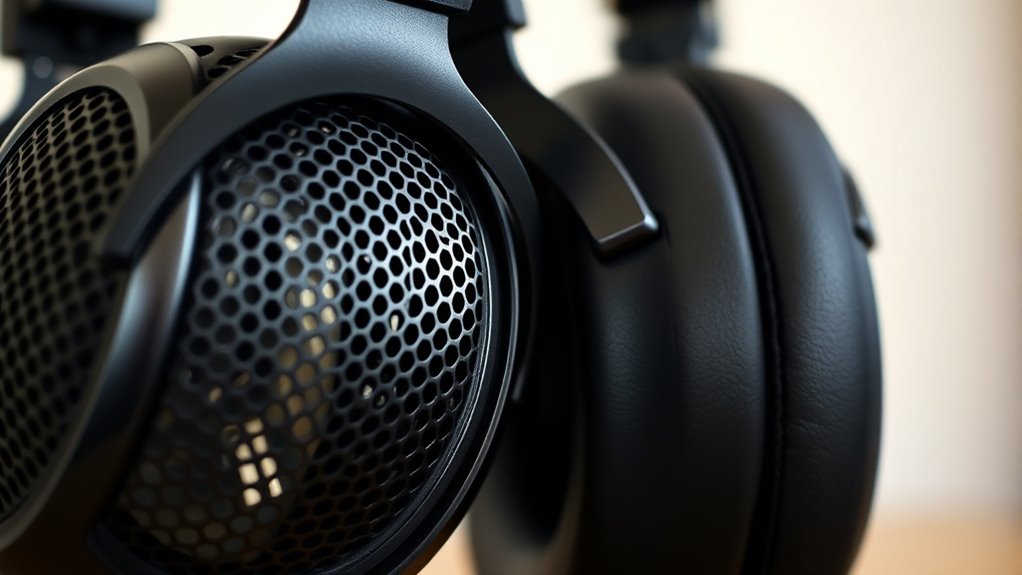
When choosing headphones, understanding the difference between open-back and closed-back designs can markedly impact your listening experience. For watching movies, your choice can influence sound quality, immersion, and comfort. Open-back headphones feature ear cups with openings or grills that allow air and sound to pass through, creating a more natural and spacious soundstage. This design enables sound to flow freely, mimicking the experience of listening through speakers in a room. As a result, you’ll notice a broader, more three-dimensional sound that can make dialogue feel clearer and more lifelike. If you enjoy hearing details and nuances in your movies, open-backs can offer a richer experience, especially for scenes with layered sound effects or complex musical scores.
Open-back headphones deliver a natural, spacious soundstage, making dialogue clearer and enhancing layered movie details.
However, open-back headphones are less effective at blocking external noise. If you’re watching in a noisy environment, you’ll likely find yourself distracted by background sounds, and others around you might also hear what you’re listening to. They tend to leak sound outward, which can disturb others nearby. This makes them less suitable for public or shared spaces but ideal for quiet home environments where immersion is key, and privacy isn’t a concern. Additionally, open-back designs can provide a more natural sound experience, which can enhance the feeling of being part of the audio environment. Many users also find that open-backs are more comfortable for extended listening sessions due to better airflow and reduced heat buildup.
Closed-back headphones, on the other hand, have sealed ear cups that trap sound inside, providing excellent noise isolation. When watching movies, this means you can focus solely on the audio without interruptions from outside noise. The sound tends to be more direct and punchy, emphasizing bass and dialogue, which some viewers prefer for a more cinematic experience. The isolation also prevents sound leakage, so others around you won’t hear what you’re watching, making these headphones practical for shared spaces or late-night viewing. Furthermore, advancements in noise cancellation technology continue to improve the overall experience, making closed-backs a popular choice for many users.
That said, closed-back designs can sometimes feel less spacious and more confined. They may cause a slight muffling effect, reducing the sense of depth and airiness in the audio. For some, this can lessen the immersive feel of a movie soundtrack, especially during scenes that rely heavily on ambient sounds or surround effects. Additionally, closed-back headphones can get warmer and less comfortable over long viewing sessions due to their sealed nature. Despite these drawbacks, many users appreciate their noise cancelling capabilities, which significantly improve the overall experience in less than ideal environments.
Furthermore, advances in sound engineering, such as sound wave manipulation, have improved how both designs deliver audio, but the core differences in soundstage and isolation remain significant factors to consider. Ultimately, your choice depends on your environment and preferences. If you prioritize natural, spacious sound and watch mostly at home in quiet settings, open-back headphones could elevate your movie experience. But if you need noise isolation, want to avoid disturbing others, or watch in noisy environments, closed-back headphones will serve you better. Consider where and how you’ll be watching movies to make the best decision for your comfort and enjoyment.
Frequently Asked Questions
Can Open-Back Headphones Cause Sound Leakage Issues?
Open-back headphones can cause sound leakage issues, especially if you’re in a quiet environment or sharing space. You might notice others hearing what you’re listening to, as these headphones don’t fully contain the sound. If you prefer privacy or are in noise-sensitive settings, closed-back headphones are better. However, open-back models often provide a more natural, immersive sound experience, making them ideal for enjoying movies at home.
Are Closed-Back Headphones More Comfortable for Long Movie Sessions?
You might think closed-back headphones are more comfortable for long movie sessions, and there’s some truth to it. Their snug fit helps block out external noise, so you can focus without fatigue. Plus, they usually have padded ear cups that stay comfortable over time. However, comfort varies by individual, so trying different styles is best. Ultimately, choose headphones that fit well and feel good, ensuring an immersive, fatigue-free viewing experience.
Do Open-Back Headphones Require More Maintenance?
Open-back headphones do require a bit more maintenance than closed-back ones because their open design exposes the drivers and ear cups to dust, debris, and moisture. You’ll want to regularly clean the ear pads and keep the drivers free from dust to maintain sound quality. Additionally, storing them properly helps prevent damage. While they might need slightly more upkeep, proper care guarantees they stay in good shape and last longer.
Which Type Offers Better Bass Response for Movies?
Imagine you’re watching an intense action scene. Closed-back headphones often give you deeper, punchier bass, making explosions feel more realistic. They trap sound better, preventing leaks and emphasizing low frequencies. Open-back headphones, while offering a more natural soundstage, usually have less pronounced bass. For movies with heavy bass elements, closed-back headphones help you feel the impact more vividly. So, if bass response matters, go for closed-back headphones.
Are Closed-Back Headphones Suitable for Outdoor Movie Watching?
Closed-back headphones are suitable for outdoor movie watching because they block out ambient noise and prevent sound leakage, so you can enjoy clear audio without disturbing others. You’ll appreciate their noise isolation, especially in noisy environments. Just make certain they’re comfortable for extended wear, and you’re set for outdoor movie sessions. Keep in mind, some closed-back models may overheat your ears, so choose a pair with good ventilation for longer use.
Conclusion
Ultimately, whether you choose open-back or closed-back headphones depends on your preferences and priorities. Open-backs offer airy ambiance, while closed-backs provide powerful privacy. Decide which suits your sound style, and you’ll discover the perfect pair for movie magic. Pick the pocket-friendly, passive, or premium option that pleases your ears. With the right choice, you’ll enjoy immersive, impeccable audio, turning every movie moment into a mesmerizing masterpiece.
Hello, I’m Art, and I’m excited to be a part of the 1Home Theatre Projector team. As a writer, I’m here to contribute my knowledge and insights to help you achieve the ultimate home cinema experience. I understand that making decisions in the world of home entertainment can be complex, and I’m here to simplify the process for you.
